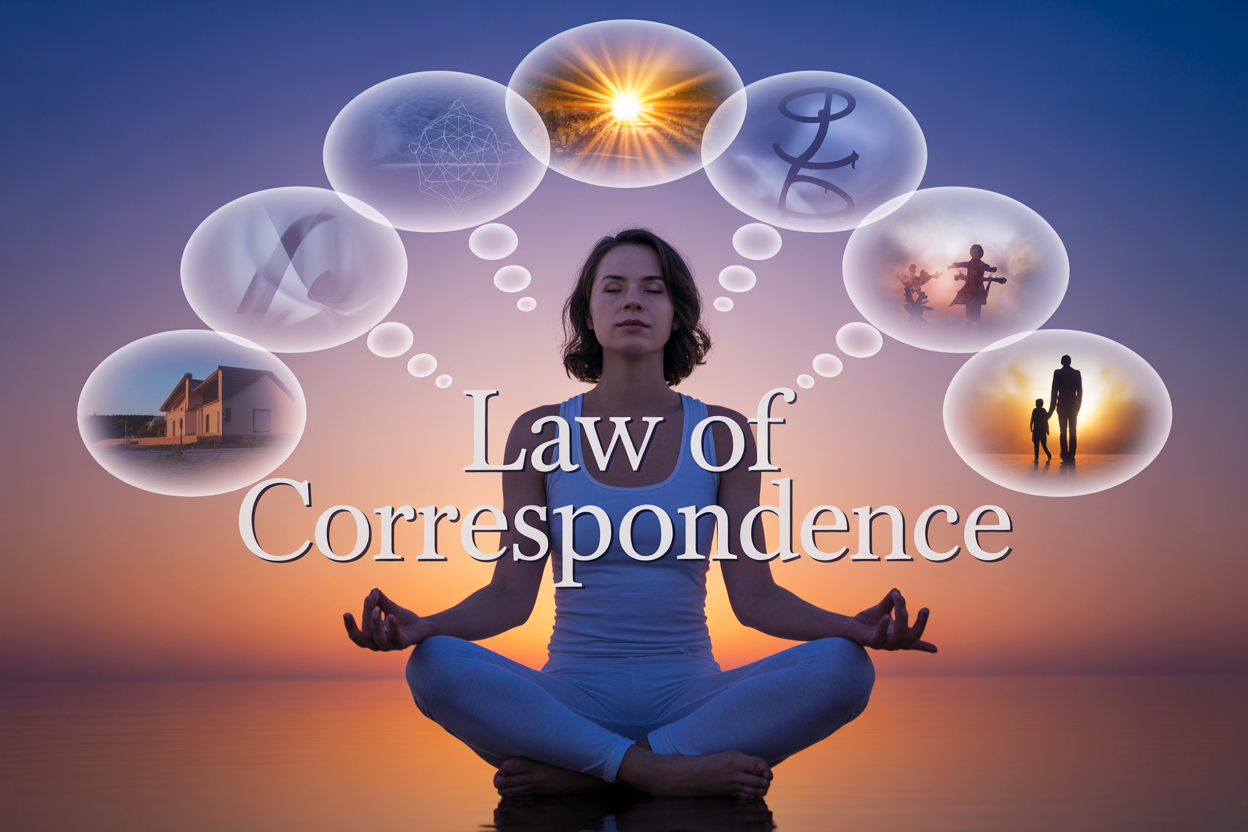Your thoughts create reality in ways you might not fully understand yet. The Law of Correspondence reveals how your inner mental world directly mirrors and shapes what shows up in your outer experience, making the connection between consciousness creates reality more than just wishful thinking.
This guide is for anyone who feels stuck in recurring life patterns, spiritual seekers exploring universal principles manifestation, and people ready to take control of their personal universe creation. If you’ve wondered why certain situations keep repeating or how successful people seem to effortlessly attract what they want, understanding this thought-reality connection will give you practical answers.
We’ll explore the science behind how belief systems and reality interact on both quantum and psychological levels, showing you exactly why your mental patterns have such power over your circumstances. You’ll discover proven mind over matter techniques to align your thoughts with your goals, plus step-by-step strategies for breaking negative thought patterns that keep you trapped in unwanted cycles.
By the end, you’ll have a clear roadmap for consciously creating the life you actually want instead of just reacting to whatever shows up.
Understanding the Law of Correspondence and Its Universal Principles

Discover the “As Above, So Below” Foundation
The ancient phrase “As Above, So Below” captures the essence of the Law of Correspondence perfectly. This timeless principle suggests that whatever happens on one level of existence reflects and influences what occurs on all other levels. Think of it like a cosmic mirror system where patterns repeat themselves across different scales and dimensions.
Your thoughts operate on the mental plane, while your physical experiences unfold in the material world. The Law of Correspondence reveals that these seemingly separate realms are actually interconnected parts of one unified system. When you understand this connection, you gain insight into how your inner mental state directly shapes your outer circumstances.
This universal principle manifests everywhere in nature. The spiral pattern of a seashell mirrors the spiral of galaxies. The branching structure of blood vessels resembles the branching of rivers and tree roots. Your personal reality follows this same principle – your internal thought patterns create corresponding patterns in your external world.
Ancient wisdom traditions recognized this truth long before modern science began exploring the thought-reality connection. Egyptian hermetic texts, Hindu scriptures, and various mystical teachings all point to this fundamental law governing how consciousness creates reality through correspondence between different planes of existence.
Learn How Inner and Outer Worlds Mirror Each Other
Your inner world serves as the blueprint for your outer experience. The beliefs, thoughts, and emotional patterns you consistently hold create a template that your external reality follows with remarkable precision. This mirroring effect operates whether you’re conscious of it or not.
When you carry persistent thoughts of limitation, you’ll notice corresponding limitations appearing in your physical circumstances. Conversely, when your mind habitually dwells on possibilities and abundance, your external world begins reflecting these mental states back to you. The key insight here is that your outer world acts as a feedback system, constantly showing you what’s happening in your consciousness.
Your relationships mirror your relationship with yourself. Your financial situation reflects your beliefs about worth and value. Your health corresponds to your mental and emotional well-being. These aren’t coincidences but direct manifestations of the correspondence principle at work.
The quality of your thoughts creates the quality of your experiences. Chaotic thinking leads to chaotic circumstances. Clear, focused thinking produces more organized and harmonious external conditions. Your personal universe creation happens through this constant mirroring between inner and outer worlds.
Recognize Patterns Between Mental and Physical Realms
The patterns connecting your mental and physical realms become visible once you know what to look for. Your body physically responds to mental stress through tension, illness, or fatigue. Your environment reflects your mental state through organization or disorder. Your opportunities align with your level of mental preparedness and expectation.
Common correspondence patterns include:
- Emotional patterns: Chronic anger manifests as inflammatory conditions, while deep sadness often appears as physical heaviness or lethargy
- Belief patterns: Self-doubt creates circumstances that reinforce feelings of inadequacy, while self-confidence attracts supportive situations
- Mental habits: Scattered thinking produces scattered results, while focused attention generates concentrated outcomes
- Expectation patterns: What you consistently expect becomes what you consistently experience
These universal principles manifestation work through repetition and consistency. Single thoughts don’t immediately transform reality, but thought patterns maintained over time create corresponding patterns in your physical experience. Breaking negative thought patterns requires recognizing these connections first.
Your personal reality operates like a sophisticated feedback loop. The mental realm sends signals that the physical realm receives and responds to accordingly. Understanding this mechanism gives you tremendous power to consciously direct your experiences by deliberately choosing your mental states and belief systems and reality creation.
The Science Behind Thought-Reality Connection

Explore Quantum Physics and Consciousness Research
Quantum physics has opened fascinating doors to understanding how consciousness creates reality. The observer effect, first documented in quantum experiments, shows that the mere act of observation changes the behavior of subatomic particles. When scientists observe electrons passing through a double-slit experiment, the particles behave differently than when they’re not being watched. This phenomenon suggests a fundamental connection between consciousness and physical reality.
Recent research in quantum biology reveals that quantum processes occur within living systems, including the human brain. Microtubules in neurons might function as quantum processors, allowing consciousness to influence matter at the most basic level. Dr. Stuart Hameroff and Sir Roger Penrose propose that consciousness emerges from quantum computations in these neural structures.
The Princeton Engineering Anomalies Research program conducted decades of experiments showing how human intention can influence random number generators and other electronic devices. Their findings indicate that focused thought can create measurable changes in physical systems, supporting the idea that thoughts create reality through quantum-level interactions.
Understand Neuroplasticity and Brain Rewiring
Your brain literally reshapes itself based on your thoughts and beliefs through neuroplasticity. Every thought you think creates neural pathways, and repeated thoughts strengthen these connections while unused pathways fade away. This biological process explains how belief systems and reality become intertwined at the cellular level.
When you consistently think positive, empowering thoughts, your brain develops stronger neural networks associated with optimism, confidence, and possibility. Conversely, negative thought patterns breaking requires conscious effort because pessimistic neural pathways have been reinforced over time.
Dr. Joe Dispenza’s research demonstrates how meditation and visualization can physically alter brain structure within weeks. Brain scans show increased gray matter in areas associated with learning and memory, while stress-related regions shrink. This neuroplasticity proves that changing your mental patterns literally changes your brain, which in turn changes how you perceive and interact with reality.
The brain doesn’t distinguish between real and vividly imagined experiences when it comes to creating neural pathways. Mental rehearsal activates the same brain regions as actual physical practice, explaining why athletes who visualize their performance often improve just as much as those who practice physically.
Examine Studies on Visualization and Manifestation
Scientific studies on visualization reveal remarkable connections between mental imagery and real-world outcomes. Research at the Cleveland Clinic showed that people who only imagined exercising specific muscles increased their strength by 35% without any physical movement. This demonstrates how mental focus can create measurable physical changes.
Sports psychology research consistently shows that athletes who combine physical practice with mental visualization outperform those who rely on physical training alone. Olympic athletes routinely use detailed mental rehearsal, imagining every aspect of their performance from muscle movements to emotional states.
Dr. Alvaro Pascual-Leone’s Harvard study found that participants who mentally practiced piano scales showed similar brain changes to those who physically practiced. The motor cortex developed new neural pathways purely through mental rehearsal, proving that visualization creates real neurological changes.
Brain imaging studies reveal that when people visualize specific scenarios, their brains activate as if those scenarios were actually happening. The visual cortex lights up during mental imagery, the auditory cortex responds to imagined sounds, and the motor cortex activates during visualized movements.
Learn About Mirror Neurons and Perception Filters
Mirror neurons fire both when you perform an action and when you observe someone else performing the same action. These specialized brain cells create empathy and learning through imitation, but they also influence how you perceive reality based on the people and media you surround yourself with.
Your brain contains millions of these mirror neurons that constantly absorb and reflect the emotional states, beliefs, and behaviors of others. This neurological mirroring explains why negative environments can unconsciously shape your thought patterns, while positive influences can elevate your mental state without conscious effort.
Perception filters, formed by your beliefs and past experiences, determine what information your brain processes and what it ignores. Your reticular activating system acts like a spotlight, highlighting information that matches your existing beliefs while filtering out contradictory evidence. This selective attention reinforces your current reality by making you notice proof that supports your worldview.
When you change your beliefs, your perception filters shift, allowing you to see opportunities and possibilities that were always present but previously invisible. This neurological process explains how belief systems and reality appear to change simultaneously – you’re literally seeing a different world through new perceptual filters.
How Your Belief Systems Create Your Personal Universe

Identify Limiting Beliefs That Block Your Success
Your personal universe operates like a sophisticated filtering system, and your belief systems serve as the primary filters determining what experiences show up in your life. Most people carry invisible barriers that sabotage their success without even realizing it.
Common limiting beliefs about money include “Rich people are greedy” or “There’s never enough to go around.” These unconscious programs create a reality where financial abundance feels impossible or morally wrong. Career-related blocks might sound like “I’m not smart enough for that promotion” or “Success requires sacrificing family time.”
The tricky part? These beliefs often masquerade as facts rather than opinions. When you think “I always mess up presentations,” your mind treats this as absolute truth rather than a changeable story. Your belief systems and reality become locked in a dance where each reinforces the other.
Warning signs of limiting beliefs:
- Repetitive negative outcomes in specific areas
- Instant emotional reactions to certain topics
- Phrases starting with “I always,” “I never,” or “People like me don’t”
- Feeling stuck despite taking action
Your thoughts create reality by filtering opportunities and shaping behavior. Someone believing “Networking is shallow” will unconsciously avoid relationship-building activities, missing career opportunities that could transform their life. The Law of Correspondence ensures your external circumstances mirror these internal convictions.
Recognize Self-Fulfilling Prophecies in Daily Life
Self-fulfilling prophecies operate as invisible architects of your personal universe creation, turning beliefs into tangible experiences through a predictable cycle. Your expectations literally program your reality by influencing perception, behavior, and outcomes.
Watch this pattern unfold in relationships. Someone believing “People always leave me” unconsciously displays clingy or defensive behaviors that push others away, confirming their original fear. Their consciousness creates reality through subtle actions aligned with their expectations.
The self-fulfilling prophecy cycle:
- Belief formation → Initial expectation develops
- Selective attention → Notice evidence supporting the belief
- Behavioral changes → Act in ways that align with expectations
- Reality confirmation → Outcomes match original belief
- Belief reinforcement → Stronger conviction for next cycle
Career scenarios demonstrate this powerfully. An employee thinking “My boss doesn’t value my contributions” might stop volunteering for projects, communicate less proactively, and interpret neutral feedback negatively. Their reduced engagement actually decreases their value, creating the exact situation they feared.
Dating provides another clear example. Someone expecting rejection might dress down, avoid eye contact, or choose partners likely to reject them. Their mind over matter techniques work in reverse, manifesting unwanted outcomes through aligned energy and behavior.
The universal principles manifestation works both ways – positive expectations create upward spirals while negative ones create downward ones. Your belief systems act as reality-generating machines, consistently producing experiences that match your dominant mental patterns.
Transform Core Beliefs for Lasting Change
Breaking free from negative thought patterns requires rewiring the fundamental programming that creates your personal universe. Surface-level positive thinking rarely works because it doesn’t address the deep belief structures governing your reality.
Core belief transformation happens through conscious reprogramming rather than willpower alone. Your thought-reality connection operates at the subconscious level, where most limiting beliefs hide beneath everyday awareness.
Effective belief transformation techniques:
| Method | Description | Timeline |
|---|---|---|
| Evidence gathering | Collect proof contradicting limiting beliefs | 2-4 weeks |
| Identity shifting | Adopt new self-concepts gradually | 3-6 months |
| Visualization rehearsal | Practice new reality scenarios mentally | Daily practice |
| Behavioral experiments | Take actions aligned with desired beliefs | Ongoing |
Start with one core belief rather than attempting wholesale personality changes. If you believe “I’m bad with money,” begin gathering evidence of financial responsibility – paying bills on time, saving small amounts, or making wise purchasing decisions.
Your consciousness creates reality through consistent mental rehearsal combined with aligned action. Spend time daily visualizing yourself as someone who naturally attracts success, makes confident decisions, or maintains healthy relationships. Feel the emotions associated with these new identity characteristics.
The Law of Correspondence ensures your external world shifts as internal patterns change. New beliefs need consistent reinforcement through both mental practice and real-world testing. Take small risks that prove your new self-concept accurate while building confidence in your expanding capabilities.
Remember that belief transformation is a process, not an event. Your personal universe rebuilds gradually as new patterns establish themselves and old ones fade away.
Breaking Free from Negative Thought Patterns

Spot Toxic Mental Loops That Keep You Stuck
Your brain loves patterns, but sometimes these patterns work against you. Toxic mental loops are repetitive thought cycles that reinforce negative beliefs and create unwanted experiences through the Law of Correspondence. These loops often sound like “I’m not good enough,” “Nothing ever works out for me,” or “I always mess things up.”
Common Signs of Toxic Mental Loops:
- Catastrophic thinking that assumes the worst possible outcome
- All-or-nothing perspectives that see situations in extremes
- Victim mentality that places blame externally
- Perfectionist standards that set you up for failure
- Comparison traps that diminish your self-worth
These patterns operate like broken records, playing the same destructive tune until you consciously interrupt them. Your thoughts create reality, so when you’re stuck in these loops, you’re literally programming your personal universe for more of what you don’t want.
The first step to freedom is awareness. Start noticing when you slip into these patterns. Keep a thought journal for one week and track recurring negative themes. You might discover that 80% of your worries never actually happen, or that your inner critic uses the same three phrases repeatedly.
Replace Fear-Based Thinking with Empowering Beliefs
Fear-based thinking stems from your primitive brain’s survival mechanism, but in modern life, these thoughts often create more problems than they solve. When you operate from fear, you attract experiences that validate those fears through the universal principles manifestation process.
Fear-Based vs. Empowering Belief Comparison:
| Fear-Based Belief | Empowering Replacement |
|---|---|
| “What if I fail?” | “What if I succeed beyond my expectations?” |
| “I can’t handle this” | “I’m capable of finding solutions” |
| “Everyone will judge me” | “My authentic self attracts the right people” |
| “I’m not smart enough” | “I’m constantly learning and growing” |
| “Money is hard to come by” | “Opportunities for abundance surround me” |
The key is catching yourself in fear-based thinking and immediately offering your mind a better option. Your belief systems and reality are intimately connected, so changing your internal dialogue changes your external experience.
Start each morning by identifying three empowering beliefs about yourself and your day. Write them down, say them out loud, and refer back to them when fear tries to take the driver’s seat. This simple practice rewires your default thought patterns over time.
Overcome Past Programming and Conditioning
Your current thought patterns didn’t develop overnight – they’re the result of years of conditioning from family, society, media, and past experiences. This programming runs so deep that you might not even recognize it as programming at all. Breaking free from negative thought patterns requires addressing these root-level beliefs.
Steps to Identify and Release Old Programming:
- Question automatic thoughts: Ask “Is this thought actually mine, or did someone else teach me this?”
- Trace beliefs to their origin: Where did you first learn that you weren’t capable, worthy, or deserving?
- Challenge inherited limitations: Just because your parents believed something doesn’t make it true for you
- Rewrite your story: Create new narratives about who you are and what’s possible
Many people carry their parents’ fears about money, relationships, or success without realizing it. Others internalize messages from childhood that no longer serve them. The consciousness creates reality principle means these outdated programs continue shaping your life until you consciously update them.
Consider working with techniques like inner child healing, belief archaeology, or working with a therapist who understands how past programming affects present reality. Sometimes the most profound shifts happen when you release beliefs you didn’t even know you were carrying.
Create New Neural Pathways for Success
Your brain is incredibly adaptable, and you can literally rewire it for success through consistent practice. Neuroscience shows that repeated thoughts and behaviors create stronger neural pathways, making positive patterns as automatic as the negative ones once were.
Strategies for Building Success-Oriented Neural Pathways:
- Visualization with emotion: Spend 10 minutes daily visualizing your desired outcomes while feeling the emotions you’d experience when achieving them
- Affirmation with conviction: Use present-tense statements that feel believable and exciting
- Success anchoring: Create physical gestures or movements associated with confident, successful states
- Gratitude rewiring: Train your brain to notice what’s working rather than what’s missing
- Future self dialogue: Regularly connect with the version of yourself who has already achieved your goals
The mind over matter techniques work best when practiced consistently over time. Start small – maybe just five minutes of positive visualization each morning. Your brain will begin defaulting to these new patterns, and your external reality will shift to match your internal changes.
Remember that creating new neural pathways takes time and repetition. Be patient with yourself as you break free from old patterns. Every time you choose a better thought, you’re literally reshaping your brain and, through the Law of Correspondence, reshaping your reality.
Evidence and Real-World Applications of Correspondence

Analyze Success Stories from High Achievers
Oprah Winfrey stands as one of the most compelling examples of how the Law of Correspondence works in practice. Born into poverty in rural Mississippi, she consistently visualized a different reality for herself. Winfrey has openly discussed how she would imagine herself interviewing influential people, hosting her own show, and creating positive change in the world. These mental images became her reality through what she describes as “aligning thoughts with desired outcomes.”
Tony Robbins transformed from a janitor struggling financially to becoming one of the world’s most sought-after motivational speakers. He credits his success to changing his internal dialogue and belief systems. Robbins practiced visualization techniques daily, seeing himself speaking to massive audiences and helping people overcome their limitations. His thoughts created reality by first reshaping his personal universe through consistent mental rehearsal.
Richard Branson attributes much of Virgin Group’s success to his unwavering belief that “business can be a force for good.” Despite having dyslexia and struggling in traditional education, he maintained an inner conviction that he could build successful companies. This thought-reality connection manifested across multiple industries, from airlines to space travel.
Consider Sara Blakely, who turned a $5,000 investment into Spanx, a billion-dollar company. She practiced positive self-talk and visualization daily, imagining her products in stores worldwide. Blakely’s belief systems and reality aligned through consistent mental focus on her goals, even when facing numerous rejections from manufacturers.
Study Historical Figures Who Applied These Principles
Albert Einstein understood the power of consciousness creates reality through his thought experiments. Before developing the theory of relativity, Einstein would visualize himself riding alongside a beam of light. These mental journeys allowed him to conceptualize complex physics problems that traditional mathematical approaches couldn’t solve. His famous quote, “Imagination is more important than knowledge,” reflects his understanding of how thoughts create reality.
Henry Ford’s success with the automobile industry demonstrates the Law of Correspondence in action. Despite widespread skepticism about motorized vehicles, Ford maintained an unshakeable belief in mass automobile production. He famously said, “Whether you think you can or you think you can’t, you’re right.” This reflects his understanding that belief systems and reality are interconnected.
Thomas Edison exemplified how persistence combined with mental visualization leads to breakthrough innovations. Edison would retreat to what he called his “thinking chair” and mentally work through problems before attempting physical solutions. His belief in the possibility of electric lighting persisted despite over 1,000 failed experiments, eventually leading to the practical light bulb.
Walt Disney’s creation of Disneyland faced massive financial and logistical challenges. Banks refused loans, calling his vision impossible. Disney continued visualizing his theme park in detail, walking through empty orange groves and describing attractions to anyone who would listen. His unwavering mental picture eventually attracted the resources needed to build his dream.
| Historical Figure | Core Belief | Manifestation Method | Result |
|---|---|---|---|
| Einstein | “Imagination > Knowledge” | Thought experiments | Theory of Relativity |
| Ford | “Thinking makes it so” | Persistent visualization | Mass automobile production |
| Edison | “Genius is 1% inspiration” | Mental problem-solving | 1,093 patents |
| Disney | “If you can dream it…” | Detailed visualization | Disneyland empire |
Examine Modern Research on Placebo Effects
Medical research consistently demonstrates that consciousness creates reality through measurable physiological changes. Studies show that patients receiving sugar pills while believing they’re taking pain medication experience real pain reduction. Brain scans reveal actual changes in neural activity in regions associated with pain processing, proving that thoughts create reality at a biological level.
The Harvard Medical School conducted groundbreaking research on the placebo effect in depression treatment. Patients who believed they were receiving antidepressants showed significant improvement in mood, even when taking inert substances. Brain imaging revealed increased activity in areas associated with emotional regulation, demonstrating how belief systems and reality intersect at the neurological level.
Research on “placebo surgeries” provides even more dramatic evidence. Patients with knee pain who underwent fake arthroscopic surgery (just small incisions without actual joint work) reported pain relief comparable to those receiving real procedures. This mind over matter technique shows how powerful expectations can produce genuine physical healing.
Parkinson’s disease studies reveal that patients receiving placebo treatments show increased dopamine production in their brains. The mere expectation of improvement triggers the body’s natural healing mechanisms, illustrating how the thought-reality connection operates at the cellular level.
Cancer research has documented cases where positive mental attitudes correlate with improved treatment outcomes. While not suggesting that thoughts alone cure cancer, studies show that patients who maintain hopeful outlooks often experience better quality of life and sometimes extended survival rates compared to those with pessimistic mindsets.
Review Case Studies in Sports Psychology and Performance
Professional athletes routinely demonstrate how universal principles manifestation works in competitive settings. Michael Jordan famously visualized successful shots before taking them, creating mental movies of game-winning moments. His practice of “seeing” the ball go through the basket before shooting became legendary among sports psychologists studying the thought-reality connection.
Olympic swimmer Michael Phelps used detailed mental rehearsal techniques coached by Bob Bowman. Phelps would visualize every aspect of his races, from diving off the blocks to touching the wall. During the 2008 Olympics, when his goggles filled with water during the 200-meter butterfly, Phelps still won gold because he had mentally swum the race so many times that his body knew exactly what to do.
Tennis champion Serena Williams practices what she calls “positive self-talk” before matches. She consciously replaces negative thought patterns with affirmations about her strength and skill. Williams credits this mental training for helping her maintain focus during high-pressure moments, demonstrating how breaking negative thought patterns enhances performance.
NFL quarterback Tom Brady worked with sports psychologists throughout his career to develop visualization techniques. Brady would mentally rehearse game situations, seeing himself completing passes under pressure. This personal universe creation through mental practice contributed to his seven Super Bowl victories.
Professional golfers provide particularly clear examples of mind over matter techniques. Tiger Woods studied meditation and mental focus from an early age, learning to quiet his mind and visualize successful shots. Golf’s mental demands make it an ideal sport for studying how consciousness creates reality, as small mental lapses often result in measurable performance decreases.
Sports psychology research shows that athletes using guided imagery improve performance by an average of 13% compared to those relying solely on physical practice. Brain scans of athletes during visualization reveal activation in the same motor cortex regions used during actual physical movement, proving that mental rehearsal creates genuine neurological preparation for peak performance.

Your thoughts and beliefs are powerful forces that actively shape the world around you. The Law of Correspondence reveals that your inner mental landscape directly mirrors your outer reality, and understanding this connection gives you incredible power to transform your life. When you align your thoughts with what you truly want, practice techniques that reinforce positive beliefs, and break free from limiting mental patterns, you’re essentially rewiring your personal universe from the inside out.
The evidence is clear – what happens in your mind creates ripple effects in your daily experiences. Start paying attention to your thought patterns today and notice how they show up in your relationships, career, and overall satisfaction with life. Take control of your inner dialogue, challenge beliefs that no longer serve you, and watch as your external world begins to shift in remarkable ways. Your reality is waiting for you to consciously create it.









